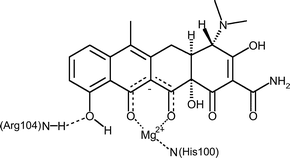How does Mg2+ affect the binding of anhydrotetracycline in the TetR protein?
Abstract
The binding of anhydrotetracycline (atc) in wild-type TetR(D), TetR(B), and four single

a Institut für Physikalische und Theoretische Chemie, Universität Erlangen-Nürnberg, Egerlandstr. 3, D-91058 Erlangen, Germany
b Institut für Mikrobiologie, Biochemie und Genetik, Universität Erlangen-Nürnberg, Staudtstr. 5, D-91058 Erlangen, Germany
c Computer-Chemie-Centrum, Universität Erlangen-Nürnberg, Nägelsbachstr. 25, D-91052 Erlangen, Germany
The binding of anhydrotetracycline (atc) in wild-type TetR(D), TetR(B), and four single

 Please wait while we load your content...
Something went wrong. Try again?
Please wait while we load your content...
Something went wrong. Try again?
C. F. Leypold, D. Marian, C. Roman, S. Schneider, P. Schubert, O. Scholz, W. Hillen, T. Clark and H. Lanig, Photochem. Photobiol. Sci., 2004, 3, 109 DOI: 10.1039/B303431N
To request permission to reproduce material from this article, please go to the Copyright Clearance Center request page.
If you are an author contributing to an RSC publication, you do not need to request permission provided correct acknowledgement is given.
If you are the author of this article, you do not need to request permission to reproduce figures and diagrams provided correct acknowledgement is given. If you want to reproduce the whole article in a third-party publication (excluding your thesis/dissertation for which permission is not required) please go to the Copyright Clearance Center request page.
Read more about how to correctly acknowledge RSC content.
 Fetching data from CrossRef.
Fetching data from CrossRef.
This may take some time to load.
Loading related content
